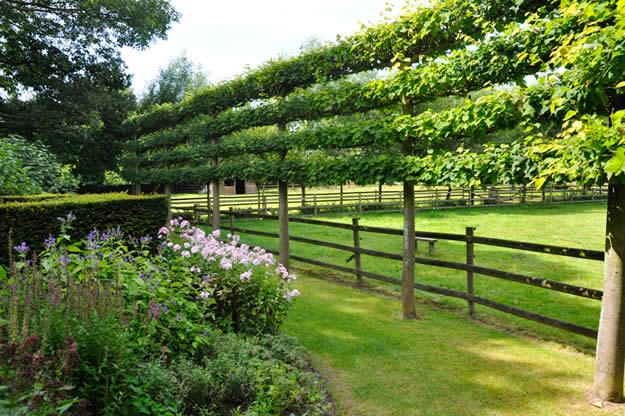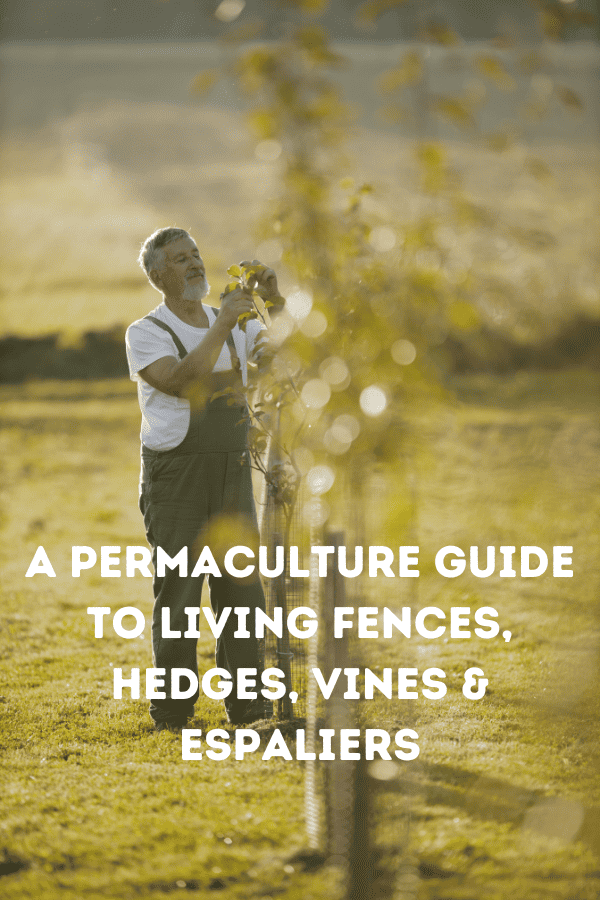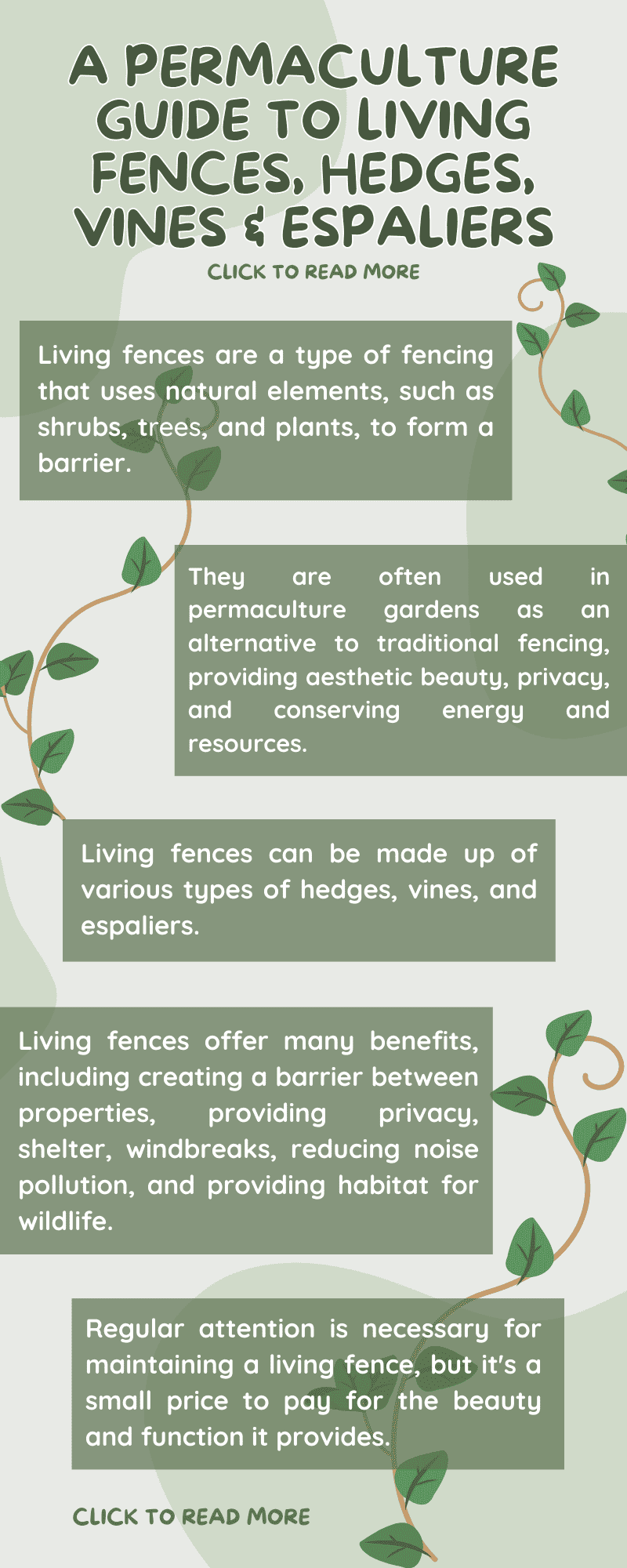

Living fences, my dear friends, are a marvelous way to grace your outdoor space with beauty, privacy, and sustainability. And with an abundance of styles and materials to choose from, creating your perfect living fence has never been easier. This permaculture guide will impart upon you the wisdom of hedges, vines, and espaliers, so that you may make the wisest choice for your garden.
Living Fence
Cultures worldwide have used hedges, the traditional form of living fences, since ancient times. Hedges come in diverse shapes and sizes and are suitable for gardens of any size. They provide unparalleled privacy and shelter for wildlife, such as birds and butterflies. Furthermore, they require minimal maintenance in comparison to other fencing options.
Vines, on the other hand, offer a unique aesthetic appeal that can enhance any outdoor space, although they do not provide the same level of privacy as hedges. These climbing plants come in various colors and textures, providing a stunning display throughout the garden or landscape. Espaliers, a type of pruned vine, can be trained along a wall or fence line for a captivating look and feel.
With these permaculture tips, individuals can select the living fence style that best suits their needs, whether it be a classic hedge or an intricate espalier!
Living fences are a type of fencing that uses natural elements, such as shrubs, trees, and plants, to form a barrier. They are often used in permaculture gardens as an alternative to traditional fencing, providing aesthetic beauty, privacy, and conserving energy and resources. Living fences can be made up of various types of hedges, vines, and espaliers.
Hedges consist of shrubs planted closely together and pruned into a specific shape. They can create an effective boundary between two areas or provide a visual screen for privacy. Hedges can also safeguard the soil from erosion due to wind or water runoff.
Vines can be used in living fences by training them along trellises or wires strung between posts. These vining plants produce abundant foliage and flowers, making them a beautiful addition to any landscape. Vines can also serve as support for other plants, adding vertical interest and dimension to the garden design.
Espaliers are created by training trees or shrubs along a framework of wires or trellises in geometric shapes, such as fans and diamonds. Espaliers offer structure, privacy, and shade throughout the season, making them an attractive addition to many landscapes. With proper care and maintenance, espaliers can last for decades or even centuries.
Living fences offer many benefits, including creating a barrier between properties, providing privacy, shelter, windbreaks, reducing noise pollution, and providing habitat for wildlife. They are also aesthetically pleasing and environmentally friendly, requiring little water and no pesticides or fertilizers.
When selecting plants for a living fence, it's essential to consider the environment and climate. Hardy shrubs like boxwood, holly, and yew are popular choices for hedges and can be planted in many climates. Vines also make great additions to living fences and come in both deciduous and evergreen varieties. Choose from wisteria, morning glory, honeysuckle, or clematis for a colorful display. For espaliers, choose fruit trees like apples or pears that will bear edible fruit.
Living fences require regular maintenance throughout the year, such as pruning back overgrown branches or trimming away dead leaves. Check for any signs of disease or insect infestation before taking action to ensure that your fence stays healthy and vibrant all year long.
Living Fence
To design a living fence, you need to be creative and consider your desired outcome and available resources. After you've selected the plants and determined their care requirements, it's time to move onto the next step: designing. First, research common fencing types, such as hedges, vines, or espaliers. Each option has its own pros and cons, so weigh them carefully before deciding which one suits your needs best. Then, plan the layout, taking into account sunlight exposure, soil quality, and water requirements for each plant.
To ensure your living fence is successful, provide adequate drainage, mulch around plants to prevent weed growth, prune back branches regularly, and ensure they receive enough water during hot summer months. Additionally, select plants that are well-suited for your climate to avoid suffering in cold winter temperatures or drought conditions. By taking these steps and maintaining a regular schedule for upkeep, you can ensure that your living fence will remain healthy and functioning for years to come.
Hedges and mounding are two popular techniques used in creating living fences. Hedges provide a formal barrier that can be both beautiful and strong, and can be planted in a straight line or arranged in curves and angles for added visual interest. Evergreen shrubs such as boxwood, privet, yew and holly are commonly used in hedges. Mounding, on the other hand, is an informal technique that involves creating small hills of soil or mulch around the perimeter of your garden or property, adding an attractive border. A diverse selection of perennials, annuals, grasses and herbs can be used in mounding to create texture, color and interest throughout the year.
Whether you choose hedging or mounding, both options allow you to create a stunning living fence that will endure the test of time. The decision between hedging and mounding depends on your unique taste and needs. Each technique has its own benefits and drawbacks, so you may need to experiment to find what works best for you and your landscape.
Hugelculture Miund
Adding a touch of magic to your permaculture garden is possible with vines and trellises. These plants climb and twine, creating a stunning vertical element that breathes new life into any space. Vines can be trained to grow along fences, walls, and other structures, while trellises provide a sturdy framework for these plants to flourish.
To create a beautiful garden with vines, choose a variety that is self-clinging or has tendrils, such as graceful wisteria, fragrant honeysuckle, or bountiful grapevine. These plants require less support and are adaptable to different climates and soil types.
After choosing the right vine for your garden, it's time to design your trellis system. You can use materials such as wood, metal, or wire mesh that will bear the weight of the vine. Make sure your trellis is secure, with sturdy metal poles or well-maintained wooden posts, and that your plant has enough space to grow.
Pruning your vine regularly is vital for its success. This process should be done when the plant has finished flowering or fruiting, and before new buds appear on young shoots. Regular pruning encourages fresh growth, more blooms, and fruit. Keep your vine well-watered during dry spells and ensure ample space and air circulation for it to thrive.
Vines and Trellises
Adding a touch of whimsy to your garden is easy with espaliers and cordon systems. These techniques require training branches in unique and imaginative shapes, creating living works of art. With espaliers and cordons, you can efficiently use vertical space, maximizing your garden's potential while adding natural beauty.
Espaliers and cordons are also useful in protecting your garden from strong winds, providing a natural shield against damage. By choosing the right plant and carefully pruning, you can create stunning shapes and designs that will bring joy and enchantment to your garden for years to come.
Maintaining a healthy and magical living fence involves regular pruning. Prune any weak or diseased branches using sharp tools to prevent damage to the plant's stem or branches. Ensure an even shape with no bare patches or overly dense foliage.
The timing and techniques used for pruning depend on the type of plant. Deciduous plants should be pruned in early spring before they leaf out, while evergreens can be pruned at any time of the year. With regular watering and fertilizing, your living fence will reach its full potential, remaining a source of wonder and beauty.
When creating a living fence, it's important to consider the needs of the wildlife attracted to your garden. Native trees and shrubs are the best choice for providing food and shelter to birds, small mammals, and insects. These plants offer visual appeal while supporting local wildlife populations.
Vines can also provide additional habitat for certain species of birds and butterflies. Choose native varieties like honeysuckle or trumpet vine to attract hummingbirds and butterflies, or vines that attract nesting sites for birds such as wrens, thrushes, robins, and finches. By choosing native varieties, you can create a healthy environment that supports a diversity of local wildlife species.
Living Fence
Regular attention is necessary for maintaining a living fence, but it's a small price to pay for the beauty and function it provides. To keep your living fence in good shape, you need to monitor it regularly for signs of disease and pests, prune it to maintain its shape and promote healthy growth, and manage overhanging branches that can impede movement or create hazards.
Periodic maintenance is required for vines to ensure that they remain healthy and don't become overly vigorous or invasive. Dead or broken stems should be removed when necessary, and occasional trimming may be necessary if they start growing out of bounds. Espaliers require regular maintenance to ensure that they maintain their form and are symmetrical and free of defects.
Although living fences require some attention, they are relatively low maintenance compared to other fencing options. By providing regular care and attention, you can ensure that your living fence will provide years of beauty and function while creating important habitat for wildlife in your garden.
FAQ
Before starting on a project like building a living fence, it's important to consider the cost. There are many factors that can affect the price of materials and installation, such as the type of fence, size, and any added features like gates or decorative elements. Hiring someone to install your living fence can also add to the total cost.
The total cost of building a living fence can vary depending on these factors and more. Generally speaking, however, you can expect to spend anywhere from a few hundred dollars up to several thousand. A simple hedge made with basic materials might cost around $500-$1,000, while a more elaborate design with decorative elements and multiple gates could easily run into the thousands of dollars.
It's important to do some research and get multiple quotes from different contractors before making a decision. This way you can find out how much your particular project will cost and make sure it fits within your budget. With proper planning and preparation, you can create an attractive living fence that adds value and beauty to your property without breaking the bank.
Establishing a living fence can take time and effort, but the benefits can be worth it. A living fence can offer privacy, wind protection, and natural beauty to your outdoor space. But how long does it take for a living fence to become established?
The answer to this question depends on many factors, such as the type of plants you choose for your fence and the climate where you live. Typically, most shrubs will be fully established in about two years, while vines and small trees may take around three years or more to grow in completely. This timeline also takes into account factors such as sunlight, water, and nutrients.
Aside from the timeline for establishment, there are other factors to consider when creating a living fence. You'll need to carefully plan what types of plants will be used, and ensure they grow well together. You'll also need to decide on a layout and design that works with the space you have available. Researching ahead of time can help ensure a successful project in the long run.
With careful planning and patience, a living fence can grow strong and beautiful for many years to come. By taking these factors into account, you can create a stunning outdoor feature that provides both function and beauty to your space.
Creating a living fence can be an attractive and rewarding way to add privacy, protect your property, and enhance the look of your garden. But once you've planted the hedge or espalier, how do you make it look its best? Is there a way to make a living fence more aesthetically pleasing?
When designing a living fence, there are several ways to create an eye-catching feature. Establishing an overall shape that is pleasing to the eye is important—for example, curved shapes tend to be more visually appealing than straight lines. Planting plants of different heights in various formations will also help create visual interest.
Adding texture can be achieved by selecting plants with different foliage types. For instance, planting evergreen shrubs for structure and ground cover will contrast nicely with bright flowering plants for color—and don’t forget about vines! Vines can add vertical interest and bring in even more color when in bloom.
By carefully selecting the right combination of plants and arranging them in an attractive formation, you can create an inviting and stunning living fence that adds value and beauty to your landscape. In addition to being aesthetically pleasing, your living fence will also provide numerous benefits such as increased privacy, wind protection, and habitat for wildlife.
Are there any considerations for living fences in cold climates? This is an important question for those looking to create a living fence in a region with cooler winter temperatures. Cold climates can present unique challenges when it comes to creating a fence that not only serves its purpose but also looks aesthetically pleasing. To ensure success, careful consideration of the environment, species selection, and maintenance are necessary.
When choosing the right species for a living fence in cold climates, it is important to take into account the hardiness of the plants. Trees and shrubs that can withstand colder temperatures should be chosen over those that cannot. Additionally, plants that have some form of resistance to common pests or diseases found in the area will be beneficial since there will be fewer problems with pest control or disease management. It is also essential to select species that are native to the region as they will be more likely to thrive than non-native varieties.
In order to maintain a healthy living fence in cold climates, special attention needs to be paid during the winter months. For example, evergreen trees may need extra protection from wind and snow damage by using burlap or other materials around their base. Fertilizer applications can also help strengthen plants' roots throughout the winter and help them survive harsh conditions. Pruning during this time of year should also be done carefully as some plants may not respond well if pruned when they’re dormant or just coming out of dormancy.
Creating a living fence in cold climates requires extra thought and planning, but with proper preparation and maintenance, it can still be successful and look great! Understanding what types of plants work best for your particular climate along with proper care will go a long way towards making sure your living fence is both functional and aesthetically pleasing all year round.
The question of whether living fences are susceptible to pest infestations is a crucial one for those considering adding one to their landscape. While living fences offer numerous benefits, such as privacy and beauty, they still require attention and maintenance to ensure they remain healthy. There are several factors to take into consideration when it comes to the potential for pest infestations, such as the type of vegetation used and the climate in which it is planted.
The type of vegetation used for a living fence can greatly affect its vulnerability to pests. Woody shrubs or trees, for instance, are more prone to attack by borers or other wood-boring insects than grasses or herbaceous plants. Selecting species that are resistant to pests can help mitigate the risk of infestation. Additionally, some species may require specialized care or treatments to prevent pests from taking hold.
Climate is also a critical consideration when it comes to pest infestations in living fences. Pests tend to thrive in warm climates, and may become more active during hot summers or dry spells. Therefore, it is essential to choose plants that are adapted to local conditions, as they are more likely to withstand potential pest outbreaks. Keeping the area around the living fence well-maintained and free from debris is also good practice, as it can help minimize potential breeding grounds for pests.
While living fences offer many benefits, they still require proper care and attention to remain healthy and free from pests. Taking into account factors such as the type of vegetation used and local climate conditions can help reduce the risks associated with pest infestations while ensuring that your living fence looks its best all year round.
To conclude, let us emphasize that adding a living fence to your permaculture garden or yard can offer both aesthetic and practical benefits. However, it is crucial to consider the costs, establishment time, and visual appeal before constructing a living fence, as well as any factors specific to colder climates. With proper planning and maintenance, you can enjoy the advantages of a living fence for years to come.
We hope that this article has enhanced your understanding of the fundamental concepts of constructing a living fence. From creating a more attractive design to addressing potential pest issues, this guide has equipped you with the necessary knowledge to develop a sustainable fencing solution. By conducting thorough research and providing adequate care, living fences can enhance the beauty and functionality of your outdoor space while promoting sustainability.
Embed this infographic on your site.

